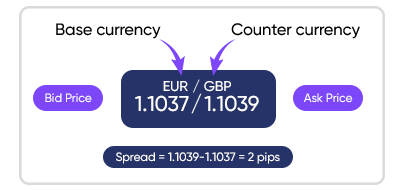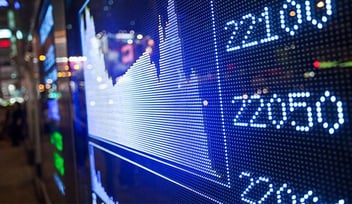Publication date
The foreign exchange market, often abbreviated as forex, or FX, is a global marketplace for exchanging currencies. It is the largest and most liquid market in the world. In order to exchange goods and services across borders, and ultimately conduct international trade and business, it is necessary to exchange currencies.
While the practice of exchanging currencies may have been around since ancient times, the end of the Bretton Woods system and the U.S. dollar’s convertibility to gold in 1971 essentially marked the birth of the modern foreign exchange market as we know it. Today, it is the largest financial market in the world. According to a report from the Bank for International Settlements, the daily trading volume for forex reached $6.6 trillion in 2020. But how exactly does it all work? This article serves as a comprehensive guide to understanding forex trading.
The forex market sets itself apart from other markets and is unique for several reasons:
- Its trading volume makes it the most liquid market in the world
- It has no central physical location, making it accessible across the world
- It’s continuous operation: it is open 24 hours a day, five days a week
- The variety of factors that affect exchange rates
- The possibility to use leverage
|
Did you know? The first forex market was created in Amsterdam in the 17th century. In those days, the city was an important hub for international trade. Rates were set according to trade in the Netherlands and for the first time, currencies could be bought and sold in one place. |
Who controls the forex market?
The foreign exchange market is a decentralised market with no specific physical location where traders can buy and sell currencies. As a result of not being under the control of a single authority such as a government or an international institution, it is essentially considered unregulated. Instead, it operates on a supply and demand principle that is steered by central banks and large commercial banks. In fact, there are four large banks which make the biggest markets in forex and consequently largely influence the market: JPMorgan, Citi, Deutsche Bank and UBS. Organised as an “over-the-counter” or OTC market, foreign currency trades can take place directly between two parties at their entire discretion without the need for a formal supervision.
While OTC markets provide obvious advantages by way of their availability, their flexibility and their cheap alternative, they also present several risks:
- Lack of transparency: without supervision, prices are negotiated directly between the buyer and the seller. This means that the prices set do not necessarily represent the reality and the parties can provide only the information they deem necessary.
- Counterparty risk: in an unregulated environment where exchanges are not supervised, there is a risk one of the parties will default before the transaction and will not be able to make the future payment.
- Volatility.
Fixed or floating exchange rates?
When buying and selling currencies, the value of a currency is established by comparing it to the value of another. This established rate, which is commonly called the exchange rate, sets the price around which a currency is traded. The value of a currency is determined by many factors including international supply and demand, and central banks.
A floating exchange rate is entirely determined by supply and demand. As a result, a floating exchange rate is constantly changing. With differences in supply and demand usually correcting themselves naturally, it is said that floating exchange rates are self-correcting. While central banks tend not to interfere in a floating regime, they may still intervene when necessary to ensure stability and reduce inflation.

To stabilise their exchange rates, some countries prefer to fix or peg their currency to another currency (usually the U.S. dollar as it is the most stable and liquid currency) rather than allow the free market to drive the currency’s value. To maintain the local rate, the country buys and sells its currency for the currency to which it is pegged and sometimes even deliberately devaluates its currency in order to combat trade imbalance. Many countries in the Middle East such as Bahrain, Oman, Qatar, Saudia Arabia and the United Arab Emirates to name a few, have pegged their currencies to the dollar. Some governments also choose to periodically reassess the value at which they peg their currency. This is the case of China. China operates what is called a crawling peg exchange rate policy to the dollar to keep the renminbi at artificially low levels and makes its exports more competitive on the global market.
In reality, currencies are neither purely floating nor purely fixed but there are nonetheless some striking differences between the two regimes with deeper implications on a currency’s value.
What are the most traded currencies?
There are 164 official national currencies circulating around the world and included in the forex market but trading usually involves a limited number of currencies. As some currency pairs can be quite rarely traded, it is necessary to resort to a widely used third or intermediary currency to complete the exchange. In fact, the four most widely used currencies account for 77% of foreign exchange. The world's leading industrial forces and their respective currencies come together annually at the G7 forum, often working together in a cooperative manner on specific international economic issues. Not to be confused with the Group of 5, also abbreviated as G5, the currencies of the G7 countries include the United States dollar, the euro, the British pound sterling, the Swiss Franc, and the Japanese yen. Altogether however, there are 7 major currencies to look out for:
The U.S. dollar
The U.S. dollar is the most traded currency in the world. As a result, it is also the undisputed reserve currency of the world. A reserve currency is a foreign currency held in significant quantities by central banks or monetary authorities which serves as a reliable and stable store of value. The USD can be found in a currency pair with all the major currencies and is often used as an intermediary currency in triangular currency transactions.
Because of its global acceptance, the U.S. dollar is used by some countries as an official currency and widely accepted as an informal alternative form of payment. It also plays a major role in the foreign exchange market for other currencies by acting as a target rate on which countries can fix their currencies to the value of the dollar.
Currency pairs that do not include the U.S. dollar are called minor pairs while exotic pairs refer to those that include currencies from emerging markets. The currencies that trade the most all include the U.S. dollar and are the following:
- EUR/USD
- USD/JPY
- GBP/USD
- USD/CHF
- AUD/USD
- USD/CAD
As the U.S. dollar represents the world’s leading reserve currency, it plays a major role in currency exchanges of all kinds. In fact, it is almost always used as the intermediary currency in currency exchanges. But could this possibly be changing?
The euro
The euro is the second most traded currency after the U.S. dollar. As the official currency of the eurozone, it is shared by 19 countries. As a result, many economic reports (on monetary policy, inflation and prices, balance of payments, etc.) related to the foreign exchange market are published each year, and knowing which report most accurately reflects market moves can be tricky. While the Eurozone comprises 19 countries, only a handful have sufficient economic might to substantially affect the euro (EUR). Keeping a close eye on economic reports by Germany and France is generally recommended as these two countries are considered the engines of the eurozone.
As is the case with the U.S. dollar, many countries in Europe that do not have the euro, as well as countries in Africa, have pegged their currencies to the euro to stabilise their rates. As a result, it represents the second-largest reserve currency in the world. Political events in the eurozone can lead to large trading volumes and because it is considered a key indicator of the general health of the eurozone and its member states, it is the most politicised currency trading on the foreign exchange market.
The Japanese yen
The Japanese yen, or JPY, is the most traded currency in Asia and is often used to gauge the overall economic health of the Asian and Pan-Pacific region. As one of the largest economies in the world, Japan is also one of the largest exporters.
Compared to other major economies, the Japanese economy has some particularities that should be considered when following the yen’s progress. Japan is among the oldest economies in terms of working age population and it has one of the lowest fertility rates. As fewer young workers are supporting the economy in terms of taxation and consumption, inflation is strikingly low in the country. As in all countries, following economic reports can provide valuable information on the state of the currency and the Tankan survey is the reference report in Japan. It is published on a quarterly basis by the Bank of Japan (BOJ).
Additionally, the yen is also known for its role in the carry trade. A carry trade is a trading strategy that involves borrowing at a low interest-rate and reinvesting in a currency that has a higher rate of return in order to pocket the difference. Because the yen has very low interest rates, the currency is particularly appreciated for this strategy. While it is the reference currency of the region, there are other foreign exchange opportunities to be made in other Asian countries given the growth of several local emerging economies.
The Great British pound
The GBP is the abbreviation of the British pound sterling. It is the official currency of the United Kingdom, its 14 British Overseas Territories as well as the crown dependencies of the Isle of Man and the Channel Islands. It is also used by many countries around the world who peg their currencies to it. The Bank of England is the central bank in charge of the British Pound Sterling. The Great British pound has the fourth highest trading volume in the world and accounts for about 13% of daily trading volume in foreign exchange markets. In 2019, that represented about 3.6 trillion U.S. dollars. It is the oldest currency in the world that is still in active use today.
The smallest unit of the British currency is the penny sterling, abbreviated at STG and some stock exchanges use GBX or GBp to differentiate the pound (GBP) from the pence (the plural of penny). In foreign exchange markets, the exchange rate of the GBP against the USD is referred to as “cable” in reference to the transatlantic submarine telecommunication cable that was installed in the mid-19th century and served to transmit currency prices between the London and New York City Exchanges.
Great Britain chose not to adopt the Euro and maintain its free-floating currency, but its close ties to the European Union meant that the currency performed well. Since Brexit, the value of the Great British Pound has fallen significantly. In fact, the GBP experienced its largest fall within a single day in 30 years shortly after the Brexit referendum results were announced.
The Swiss franc
Despite its small size, Switzerland and its currency have a big impact on the foreign exchange market. The perceived stability of the Swiss franc, abbreviated as CHF for Confoederatio Helvetica Franc, along with the stability of the political system and the relatively low inflation rates all contribute to explaining why the Swiss currency has become a safe haven. Safe haven currencies refer to currencies that tend to retain and increase in value during times of turmoil. Switzerland also appears to be a prized destination for investors because of its low debt level and lack of deficit. Although this has slightly changed since the Covid-19 pandemic and the need to urgently respond, the Swiss franc remains firmly in demand.
Unsurprisingly, the demand for the currency as a safe haven increased substantially after the 2008 crisis, and it has done so again with the onset of the Covid-19 pandemic, so it appears that the interest for the Swiss Franc is likely to persist. However, the currency’s status as safe haven can also pose a problem for the national economy. As the demand skyrockets, overvaluation of the currency increases leading to relatively expensive exports and a depression in domestic demand. In fact, to contain the currency’s overvaluation following the 2008 crisis, the Swiss National Bank (SNB) decided to briefly peg the national currency to the Euro before unexpectedly removing the peg again in 2015.
The Australian dollar
The Australian pound became the Australian dollar, or AUD, in 1966. It is the official currency in Australia and several independent territories in the South Pacific including Papua New Guinea, Christmas Island, the Cocos Islands, Nauru, Tuvalu, and Norfolk Island. While the Australian economy may only be 14th in terms of GDP, its currency counts among the most traded in the world.
The strong interest in the Australian dollar is due to the country’s so-called 3Gs: geology, geography and government. Australia is particularly rich in natural resources. In fact, demand for natural resources from countries in Asia, including China and India, significantly influence the Australian Dollar’s exchange rate. Like the Canadian dollar, the Australian dollar is closely tied to commodity prices and is considered countercyclical, appreciating in bad times and depreciating in good times. The country’s geographical location makes it well-positioned to cater for its rapidly growing neighbouring Asian countries. Lastly, the government policy ensures a stable government and economy while the institution in charge of controlling the country’s currency, the Reserve Bank of Australia (RBA), is a rather conservative institution that advocates non-interventionism, a strong control of inflation and generally high interest rates.
The Canadian dollar
Abbreviated CAD, the Canadian dollar is the seventh most held currency. It sets itself apart from previously mentioned currencies because Canada’s economy ranks lower on the list of major world economies. Despite this, the country ranks high among the top exporters in the world. Just like Australia, Canada’s currency is considered a commodity currency. Its exports in petrol, wood products and minerals are considerable, and the performance of the Canadian dollar is closely related to movements in commodity prices. Furthermore, because of the close ties between the Canadian and American economies, trading Canadian dollars implies keeping a close eye on events in the United States.
The forgotten currency
Despite its colossal weight in the world economy, the Chinese currency is not considered a major world currency. For a range of political and economic reasons, including relinquishing control over the currency by free floating it, and running trade deficit, among others, China needs to implement reforms in its monetary, foreign exchange, and financial systems before it can see its currency rank among the strongest in the world. While it joined the U.S. dollar, euro, yen, and British pound in the IMF's special drawing rights (SDR) basket in 2016, China's currency is still a light weight on the world scene.
Reading currency exchanges
Currencies are identified by three-letter codes established by the International Organization of Standardization (ISO). Most are usually abbreviated to the country name and the currency name although exceptions to this rule can be found, such as the Euro (EUR) and the particular case of the Chinese currency. The renminbi is abbreviated CNY when traded on mainland China and CNH when traded offshore from mainland China.
As currency exchange implies the purchase and/or sale of a currency, it must necessarily be done in pairs. The order of the currencies in the pair is important to understand. When buying a currency, the first currency of the pair (also called the base currency) is the one being purchased, while the second currency (or quote currency) is the one that is being sold. As an example, if you buy EUR/USD you are buying Euros and selling US Dollars.
As you’ll notice when viewing currency prices, most are priced up to the fourth decimal point. A pip, or percentage in point, is the smallest price move possible on the foreign exchange market. Currency pairs tend to be priced to four decimal points with a pip referring to the fourth decimal point. While the bid price refers to the highest price a buyer is willing to pay, the ask price represents the lowest price at which the seller is willing to sell. The difference between the two is called the spread. Depending on the currencies involved, the time of day and various macroeconomic factors, the spread between the two prices may either narrow or widen.

Two other concepts commonly encountered in the forex world are long positions and short positions. Having a long or short position on the foreign exchange market means betting on whether the currency pair will go up or down in value. In a long position, the trader expects the currency to increase in value while a short position is essentially the opposite: the trader expects the price to depreciate.
Types of transactions
While currencies can be exchanged instantly, there can also be instances when the time factor comes into play. Currency fluctuations affect the world of trade in many ways and can have a serious impact on a company. Changes in currency rates have an impact both on the cost of supplies that businesses purchase as well as the attractiveness of the products and services a company sells abroad which is why choosing when to make international payments based on the exchange rate can help businesses save money.
A currency purchaser can choose from various options depending on whether the cross-currency payment needs to be done immediately or in the future. The current market price for the exchange of one currency for another is called the spot exchange rate. In these cases, trade can happen nearly immediately with a standard delivery date of two business days.
Currency fluctuations over time can impact a company’s revenue and expenses, obliging it to build in a risk cushion. Measures can be taken to guard from such surprises. Entering into deliverable forward payment contracts can ensure financial protection against unexpected, expected and anticipated movements and so address currency volatility. A forward payment contract consists of locking in an exchange rate today for settlement at a specific future date or within a range of dates. Forward payment contracts are private and customisable agreements made between the client and the bank, or financial service provider. Their main advantage lies in the fact it avoids the risk of currency fluctuations by enabling companies to operate on a “buy now pay later” principle and provides certainty with regard to the cost impact of their international payments.
Cross-currency payments

Making international payments comes at a cost. All banks apply transfer fees but they all set their own rates. These fees can quickly add up. They usually include a fixed money transfer fee as well as a fee based on how much money is being transferred. Additionally, rates may vary depending on the currency the money is being converted to and extra charges can also be applied to expedite quicker payments.
Beyond the standard international transfer fees, it is also important to know that margins on the daily exchange rates are also typically applied. This margin is the difference between the mid-market exchange rate, in other words the midpoint between the buy and sell prices of two currencies, and the exchange rate offered by the bank or currency exchange service. As exchange rates change every second, banks and currency exchange services apply a margin to profit and protect themselves from the fluctuating rates. Some banks also charge the recipient of the international payment. This can be problematic, especially for businesses, which is why it is important to know how these fees can be paid and settled. In fact, there are three different invoicing options to choose from when making international payments: BEN, SHA, OUR.
Given the multitude of currencies, bank accounts and cross-border payments happening every day in the world, some sort of system had to be implemented to make sure international payments are safely made between the right accounts. Whichever bank or banking service provider you use to transfer money across borders, you’ll need to provide certain details to identify the two bank accounts that will take part in the exchange. Depending on the countries in which these accounts are located, you’ll be required to share what are called an IBAN code or a SWIFT code.
Keeping up with the currencies
With currency rates playing such an important role in the cost of supplies and the attractiveness of the products and services sold, and by extension on a company’s revenues, it is crucial for any internationally operating company to keep abreast of world events that could impact currency changes, learn to read the data and anticipate currency fluctuations. Successful companies understand that adopting a strong payment strategy that suits their business model can go a long way to helping them reduce currency conversion costs and exchange rate risks while maximising returns. Beyond the macroeconomic level, high costs and long transaction and processing times are plaguing the banking world and represent a major pain point for businesses of all sizes. As a result, the fintech world is stepping in to better meet the needs of companies and B2B payment trends are evolving. Contact our experts today to optimise your international payment strategy and start using currency fluctuations to your company’s advantage.
Forex terminology
The forex is full of unusual terms and acronyms that can be confusing for those who are not yet well acquainted with them. Understanding forex trading also means understanding its specific terminology. Head over to our glossary for more detailed information about the most important terms every forex trader should know.
Topics






